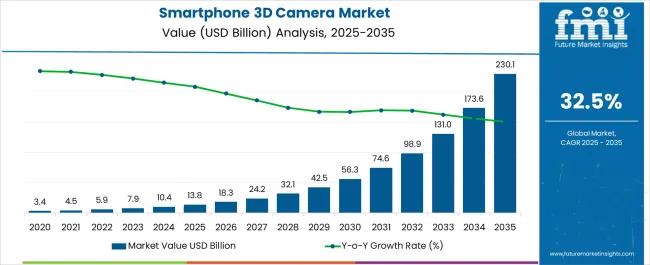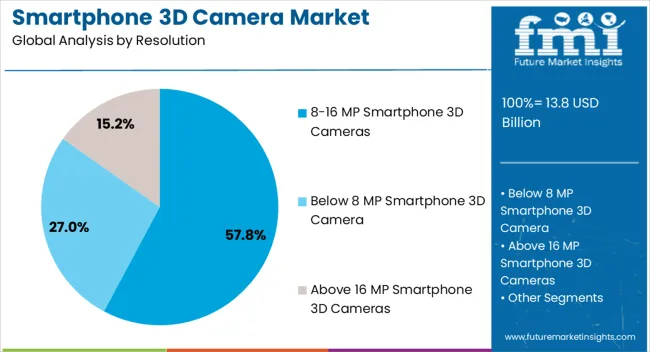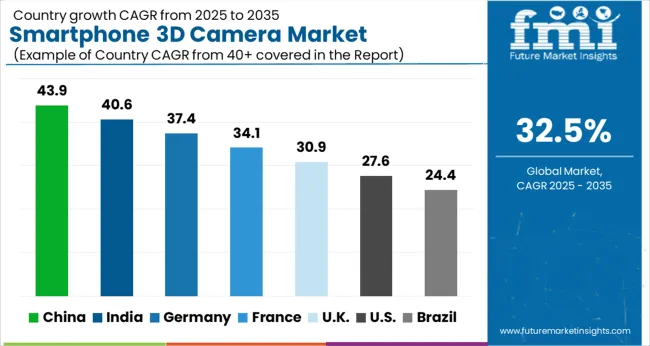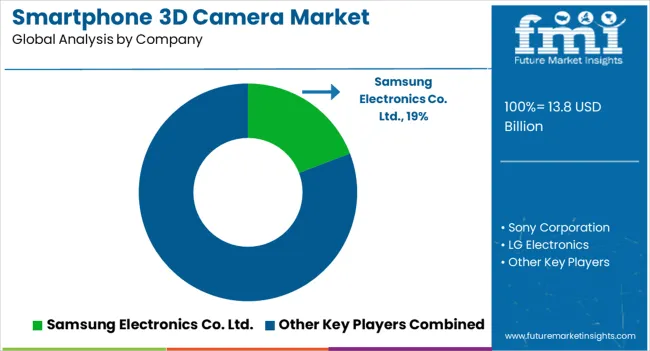The Smartphone 3D Camera Market is estimated to be valued at USD 13.8 billion in 2025 and is projected to reach USD 230.1 billion by 2035, registering a compound annual growth rate (CAGR) of 32.5% over the forecast period.

| Metric | Value |
|---|---|
| Smartphone 3D Camera Market Estimated Value in (2025 E) | USD 13.8 billion |
| Smartphone 3D Camera Market Forecast Value in (2035 F) | USD 230.1 billion |
| Forecast CAGR (2025 to 2035) | 32.5% |
The smartphone 3D camera market is witnessing strong growth momentum, driven by the rising integration of advanced imaging technologies in consumer devices. Increasing demand for immersive applications, such as augmented reality, facial recognition, and depth sensing, is shaping the market outlook and reinforcing the adoption of high-resolution 3D cameras in smartphones.
Continuous advancements in sensor miniaturization, artificial intelligence, and image processing software are enhancing performance while maintaining cost efficiency, encouraging wider deployment across mid-range and premium smartphones. Manufacturers are focusing on developing innovative 3D imaging solutions that support greater depth accuracy and superior image quality to meet consumer expectations for advanced photography and security features.
The rapid expansion of mobile-based augmented and virtual reality ecosystems, along with growing consumer preference for smartphones equipped with advanced imaging capabilities, is creating new opportunities for growth As global smartphone penetration continues to rise and user expectations evolve, the market for 3D cameras is expected to expand steadily, supported by investments in hardware innovation, software optimization, and ecosystem development.
The smartphone 3d camera market is segmented by resolution, and geographic regions. By resolution, smartphone 3d camera market is divided into 8-16 MP Smartphone 3D Cameras, Below 8 MP Smartphone 3D Camera, and Above 16 MP Smartphone 3D Cameras. Regionally, the smartphone 3d camera industry is classified into North America, Latin America, Western Europe, Eastern Europe, Balkan & Baltic Countries, Russia & Belarus, Central Asia, East Asia, South Asia & Pacific, and the Middle East & Africa.

The 8 to 16 MP smartphone 3D camera resolution segment is projected to hold 57.8% of the market revenue share in 2025, making it the dominant resolution category. This leadership is being driven by the balance it offers between image clarity, processing efficiency, and affordability, which appeals to a broad consumer base.
Cameras in this range provide sufficient depth accuracy and high-quality imaging for mainstream applications such as facial recognition, augmented reality, and enhanced mobile photography, without creating excessive demands on device storage or processing power. The segment is benefiting from its widespread adoption in both premium and mid-tier smartphones, where performance and cost considerations must align to meet mass-market demand.
Advancements in complementary technologies, including AI-powered image enhancement and depth-sensing algorithms, are further strengthening the value proposition of this resolution category As consumers continue to demand enhanced imaging capabilities without significantly higher device costs, the 8 to 16 MP resolution segment is expected to retain its leadership position and play a crucial role in driving overall market expansion.
Researchers are increasingly focusing on the development of smartphones with integrated 3D sensors that can sense movement and capture specific dimensions of objects and environments. Additionally, its superior properties, such as its ability to detect objects with a high degree of precision, high performance, and HD clarity, this is sure to increase the product's popularity among youngsters. Thus, this will augment the demand for the smartphone 3D camera market over the forecast period, as expected.
As a result of the increased demand for 3D cameras in phones coming from customers, several manufacturers are adopting 3D technology in their smartphone cameras to meet the growing demand from customers. In addition to the depth sensors, these 3D cameras are equipped with the ability to record a quarter million three-dimensional measurements per second, allowing them to provide real-time 3D modeling of objects at any time.
Having 3D capabilities integrated into smartphones will create new market opportunities and enhance sales in the future. Moreover, there is a high probability that an increasing number of virtual reality applications, as well as home automation, is likely to positively contribute to the growth of the global market in the years to come.
The demand for easy and reliable generation of 3D models of real objects and environment has witnessed traction in the recent past. 3D cameras are essential for capturing and displaying a 3D scene of the objects in an environment. With the growing adoption of smartphones across the world, 3D camera is expected to become an essential feature of smartphones. Modern smartphones offer improved interactive features and have now open up new possibilities for 3D modeling.
Technologies Used in Smart Phone 3D Cameras:
Currently, most of the smartphones 3D cameras are designed on the basis of stereoscopic technology. Stereoscopic camera technology offers reliability, high quality of pictures, and precision while capturing 3D image of any object, hence, most of smartphone 3D camera vendors are deploying this technology to design 3D cameras for smartphones. Thus, it is one of the major driving factor for the growth of smartphone 3D camera market. Moreover, entertainment and media industry is witnessing intense surge in the 3D content High end smartphones from the leading manufactures integrate innovative camera with high resolution equivalent to hand handled cameras. In addition to this, smart phones are integrated with 3D sensors that can sense movements and enable smartphone user to capture precise dimensions of environment and objects. Because of these enticing features, smartphones are gaining popularity in the young generation which in turn contributing to the growth of market. However, factors such as high cost of smartphones integrated with 3D camera and compatibility issues are currently restricting the growth of the market.
Asia-Pacific region presents largest market opportunity for smartphone 3D camera market. The growing usage of smartphones and increase in purchasing power of consumers is driving the growth of the market. In countries such as China and India, there are more than 800 million smartphone users, according to World Bank. Apart from this, most of the smart phone vendors manufacture their smartphones in countries such as China, Japan, and Taiwan.
In North America region, smartphone 3D cameras have won widespread acceptance for both personal and business use. Increasing crave of viewing the external object and environment in 3 dimensional view through smartphones is contributing to the growth of the market. Increasing awareness of 3D camera enabled smartphones and growing consumer spending power is contributing to the growth of the market in the Latin America and Middle East and Africa regions.
LG Electronics, Intel Corporation, Sony Corporation, Panasonic Corporation, and Samsung Electronics are key players of global smartphone 3D camera market.
The report is a compilation of first-hand information, qualitative and quantitative assessment by industry analysts, inputs from industry experts and industry participants across the value chain. The report provides in-depth analysis of parent market trends, macro-economic indicators and governing factors along with market attractiveness as per segments. The report also maps the qualitative impact of various market factors on market segments and geographies.

| Country | CAGR |
|---|---|
| China | 43.9% |
| India | 40.6% |
| Germany | 37.4% |
| France | 34.1% |
| UK | 30.9% |
| USA | 27.6% |
| Brazil | 24.4% |
The Smartphone 3D Camera Market is expected to register a CAGR of 32.5% during the forecast period, exhibiting varied country level momentum. China leads with the highest CAGR of 43.9%, followed by India at 40.6%. Developed markets such as Germany, France, and the UK continue to expand steadily, while the USA is likely to grow at consistent rates. Brazil posts the lowest CAGR at 24.4%, yet still underscores a broadly positive trajectory for the global Smartphone 3D Camera Market. In 2024, Germany held a dominant revenue in the Western Europe market and is expected to grow with a CAGR of 37.4%. The USA Smartphone 3D Camera Market is estimated to be valued at USD 5.1 billion in 2025 and is anticipated to reach a valuation of USD 58.6 billion by 2035. Sales are projected to rise at a CAGR of 27.6% over the forecast period between 2025 and 2035. While Japan and South Korea markets are estimated to be valued at USD 631.2 million and USD 429.0 million respectively in 2025.

| Item | Value |
|---|---|
| Quantitative Units | USD 13.8 Billion |
| Resolution | 8-16 MP Smartphone 3D Cameras, Below 8 MP Smartphone 3D Camera, and Above 16 MP Smartphone 3D Cameras |
| Regions Covered | North America, Europe, Asia-Pacific, Latin America, Middle East & Africa |
| Country Covered | United States, Canada, Germany, France, United Kingdom, China, Japan, India, Brazil, South Africa |
| Key Companies Profiled | Samsung Electronics Co. Ltd., Sony Corporation, LG Electronics, Huawei Device Co., Ltd., Oppo, Intel Corporation, and Microsoft Corporation |
The global smartphone 3d camera market is estimated to be valued at USD 13.8 billion in 2025.
The market size for the smartphone 3d camera market is projected to reach USD 230.1 billion by 2035.
The smartphone 3d camera market is expected to grow at a 32.5% CAGR between 2025 and 2035.
The key product types in smartphone 3d camera market are 8-16 mp smartphone 3d cameras, below 8 mp smartphone 3d camera and above 16 mp smartphone 3d cameras.
In terms of , segment to command 0.0% share in the smartphone 3d camera market in 2025.






Our Research Products

The "Full Research Suite" delivers actionable market intel, deep dives on markets or technologies, so clients act faster, cut risk, and unlock growth.

The Leaderboard benchmarks and ranks top vendors, classifying them as Established Leaders, Leading Challengers, or Disruptors & Challengers.

Locates where complements amplify value and substitutes erode it, forecasting net impact by horizon

We deliver granular, decision-grade intel: market sizing, 5-year forecasts, pricing, adoption, usage, revenue, and operational KPIs—plus competitor tracking, regulation, and value chains—across 60 countries broadly.

Spot the shifts before they hit your P&L. We track inflection points, adoption curves, pricing moves, and ecosystem plays to show where demand is heading, why it is changing, and what to do next across high-growth markets and disruptive tech

Real-time reads of user behavior. We track shifting priorities, perceptions of today’s and next-gen services, and provider experience, then pace how fast tech moves from trial to adoption, blending buyer, consumer, and channel inputs with social signals (#WhySwitch, #UX).

Partner with our analyst team to build a custom report designed around your business priorities. From analysing market trends to assessing competitors or crafting bespoke datasets, we tailor insights to your needs.
Supplier Intelligence
Discovery & Profiling
Capacity & Footprint
Performance & Risk
Compliance & Governance
Commercial Readiness
Who Supplies Whom
Scorecards & Shortlists
Playbooks & Docs
Category Intelligence
Definition & Scope
Demand & Use Cases
Cost Drivers
Market Structure
Supply Chain Map
Trade & Policy
Operating Norms
Deliverables
Buyer Intelligence
Account Basics
Spend & Scope
Procurement Model
Vendor Requirements
Terms & Policies
Entry Strategy
Pain Points & Triggers
Outputs
Pricing Analysis
Benchmarks
Trends
Should-Cost
Indexation
Landed Cost
Commercial Terms
Deliverables
Brand Analysis
Positioning & Value Prop
Share & Presence
Customer Evidence
Go-to-Market
Digital & Reputation
Compliance & Trust
KPIs & Gaps
Outputs
Full Research Suite comprises of:
Market outlook & trends analysis
Interviews & case studies
Strategic recommendations
Vendor profiles & capabilities analysis
5-year forecasts
8 regions and 60+ country-level data splits
Market segment data splits
12 months of continuous data updates
DELIVERED AS:
PDF EXCEL ONLINE
3D Camera Market Growth – Trends & Forecast 2025 to 2035
3D Somatosensory Virtual Fitting Market Size and Share Forecast Outlook 2025 to 2035
Camera Accessories Market Size and Share Forecast Outlook 2025 to 2035
3D Imaging Surgical Solution Market Size and Share Forecast Outlook 2025 to 2035
3D Printing Industry Analysis in Middle East Size and Share Forecast Outlook 2025 to 2035
3D Printed Dental Brace Market Size and Share Forecast Outlook 2025 to 2035
3D Reverse Engineering Software Market Forecast and Outlook 2025 to 2035
3D Automatic Optical Inspection Machine Market Size and Share Forecast Outlook 2025 to 2035
3D Ready Organoid Expansion Service Market Size and Share Forecast Outlook 2025 to 2035
3D-Printed Prosthetic Implants Market Size and Share Forecast Outlook 2025 to 2035
3D Printing Ceramics Market Size and Share Forecast Outlook 2025 to 2035
3D NAND Flash Memory Market Size and Share Forecast Outlook 2025 to 2035
3D Printing Metal Market Size and Share Forecast Outlook 2025 to 2035
3D Bioprinted Organ Transplants Market Size and Share Forecast Outlook 2025 to 2035
3D Mapping and Modeling Market Size and Share Forecast Outlook 2025 to 2035
3D Audio Market Size and Share Forecast Outlook 2025 to 2035
3D Printing in Aerospace and Defense Market Analysis - Size, Share, and Forecast Outlook 2025 to 2035
3D Printed Maxillofacial Implants Market Size and Share Forecast Outlook 2025 to 2035
3D Surgical Microscope Systems Market Size and Share Forecast Outlook 2025 to 2035
3D-Printed Personalized Masks Market Size and Share Forecast Outlook 2025 to 2035

Thank you!
You will receive an email from our Business Development Manager. Please be sure to check your SPAM/JUNK folder too.
Chat With
MaRIA